There are several virtual conference platforms you can use to host your online event. The best conference platforms let organizers host live stream events, accommodate large audiences, market their events, collect insightful data, broadcast on multiple platforms and devices, and encourage attendee engagement.
To select a virtual event platform for your online conferences and virtual meetings, use the insights provided in this guide to make an informed decision. While our focus is on the best virtual conference platforms for large events, these tools can often be used to run a smaller online meetings as well.
This guide reveals the top 10 virtual conference platforms, including features and pricing information for each so you can make a good decision as the event organizer.
Top 10 Virtual Conference Platforms
We have selected some of the best virtual conference platforms, according to user rankings on Capterra. Please note that these rankings change over time as more users review the apps and other solutions.
1. Grip (Capterra Average Rating: 5 stars out of 5)
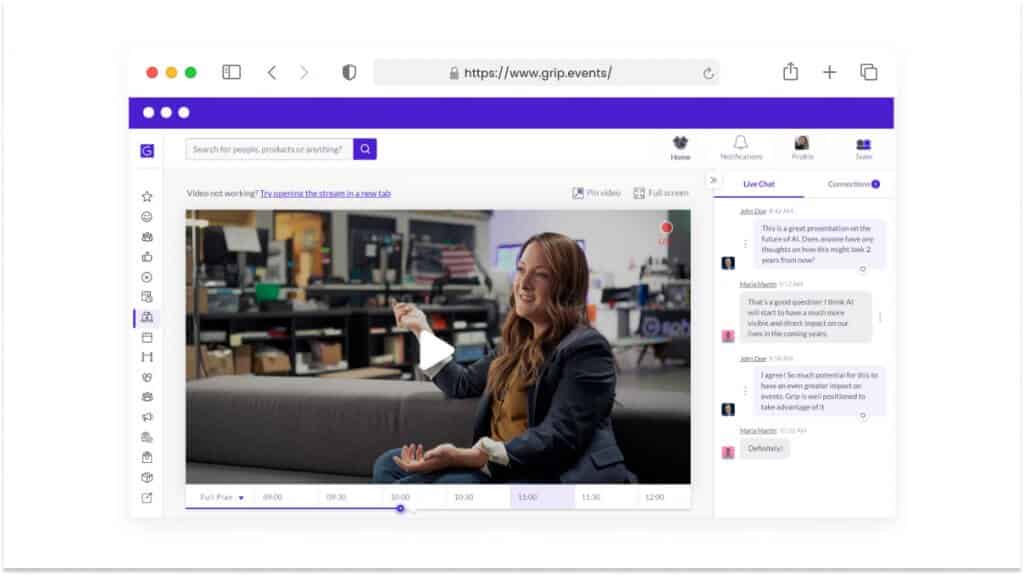
Grip offers virtual conference tools suitable for virtual and hybrid event experiences. As the event host, you can stream your online experience to other major streaming solutions like Zoom, YouTube, and Twitch. The software enhances networking, a key part of the attendee experience, through its AI-powered event matchmaking tool. Organizers can add a live stream to Grip’s main stage, and it automatically shows content on the users’ feeds.
The platform’s Event Matchmaking tool creates a networking experience through speed networking, roundtables, instant video calls, multi-person meetings, and hosted buyer meetings. This matchmaking capability makes this platform stand out compared to other virtual meeting platforms.
In addition to major streaming solutions, Grip also integrates with Arena to enhance audience engagement. Arena Live Chat is a live chat tool that improves engagement through instant messaging, Q&As, polls, surveys, group chat, and more.
Arena Live Blog is another effective tool for digital agencies and companies looking to share quick updates as their conference unfolds. To capitalize on data collected from customers, companies also use Arena Personas plugged into their Customer Data Platform (CDP) to build customer profiles and better understand their preferences and interests.
2. Demio (Capterra Average Rating: 4.7 stars out of 5)
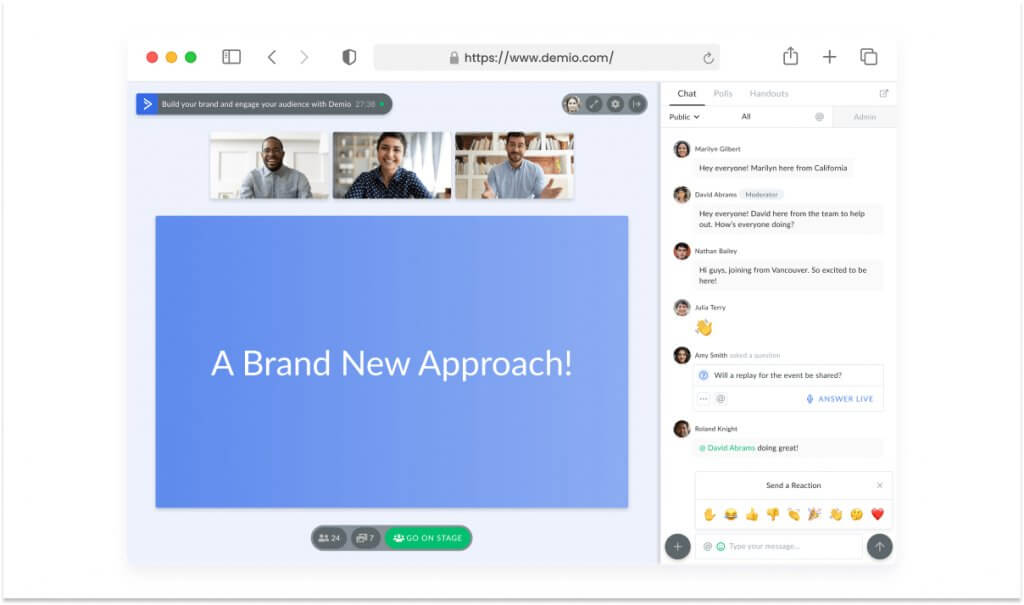
Demio is one of our top virtual conference platforms because of its simple event registration capabilities, engagement benefits, and analytics tools.
Demio offers real-time HD streaming, simulated events, and pre-recorded presentations. Organizers can add their own logo and branding, and attendees can join virtual conferences with just one click.
Notable, the Demio platform integrates with over 50 third-party software apps like HubSpot, Drip, ConvertKit, and MailChimp. Organizers can view attendees, collect contact details, manage their registration, and export contacts to a CSV file.
Demio offers a 14-day free trial, so you can evaluate if it is right for your needs. The company offers three paid plans: Starter ($34 per month with 50 attendees), growth ($69 per month with 150 attendees), and premium (request quote for pricing and support for more than 500 attendees).
3. Livestorm (Capterra Average Rating: 4.7 stars out of 5)
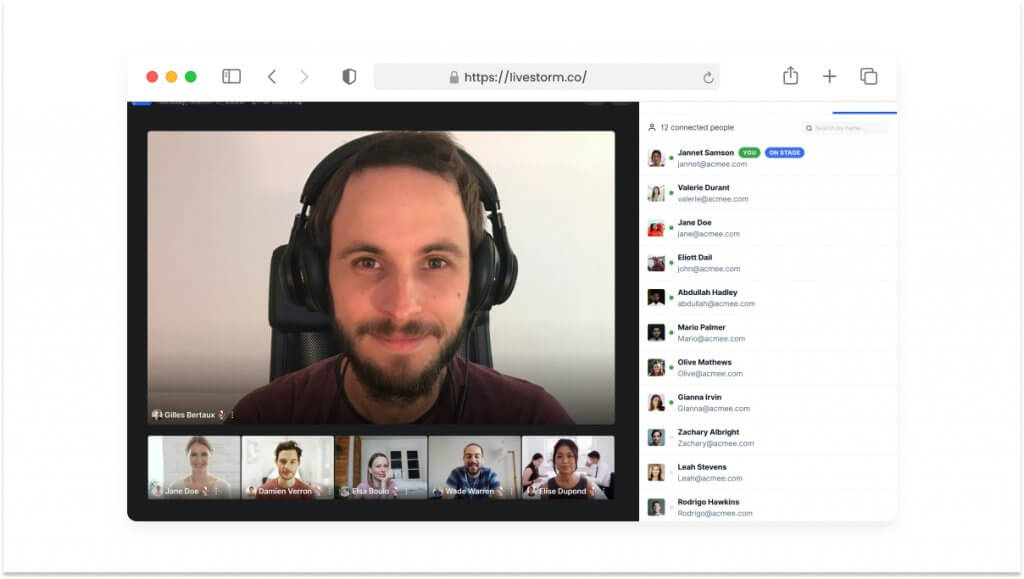
Livestorm is a browser-based platform that offers powerful live streaming features, where events can be hosted on desktop and mobile devices. The webinar software can be used for pre-recorded online events, live events, or on-demand events.
Organizers can track engagement, answer questions, add polls, chat with attendees, send emails, and use these insights to improve the experience for attendees.
Companies can promote their events through branded registration pages, built-in social sharing, company pages, automated emails, and more. Livestorm has solid features to enable an engaging interactive experience like Q&As for event guests, call-to-actions, live answer notifications, live attendees lists, and screen sharing.
Like several of the other online community platforms profiled here, Livestorm offers several plans. To take the platform for a test drive and see how it performs with interactive webinars, try the free plan which has a maximum event duration of 20 minutes. To accommodate more event participants, top-tier support, and other features, sign up for the Pro, Business, or Enterprise plan.
4. Communique Conferencing (Capterra Average Rating: 4.7 stars out of 5)
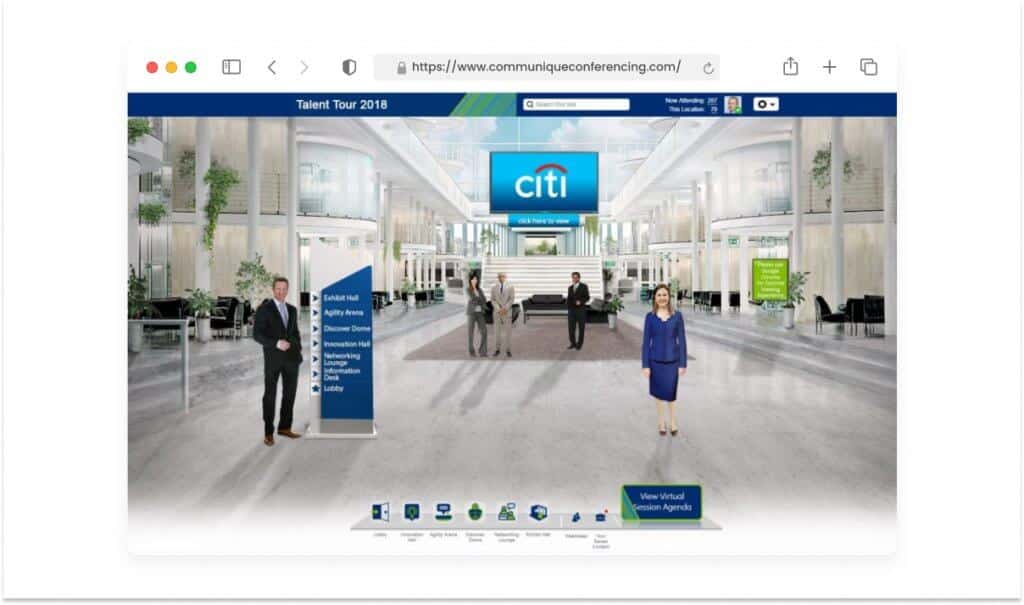
Communique Conferencing has effective solutions for audio conferencing, web conferencing, and virtual community events. Its webcasting software lets organizers broadcast video and audio to over 30,000 attendees. This large virtual venue capacity means the platform pairs well with even the largest events.
Its virtual conferencing platform creates an online environment that includes features for networking, keynote presentations, booths, exhibit halls, and conferences. It also has a custom solution for hosting virtual career fairs and hybrid events. To find out more about the platform’s pricing, contact the company.
5. Zoom (Capterra Average Rating: 4.6 stars out of 5)
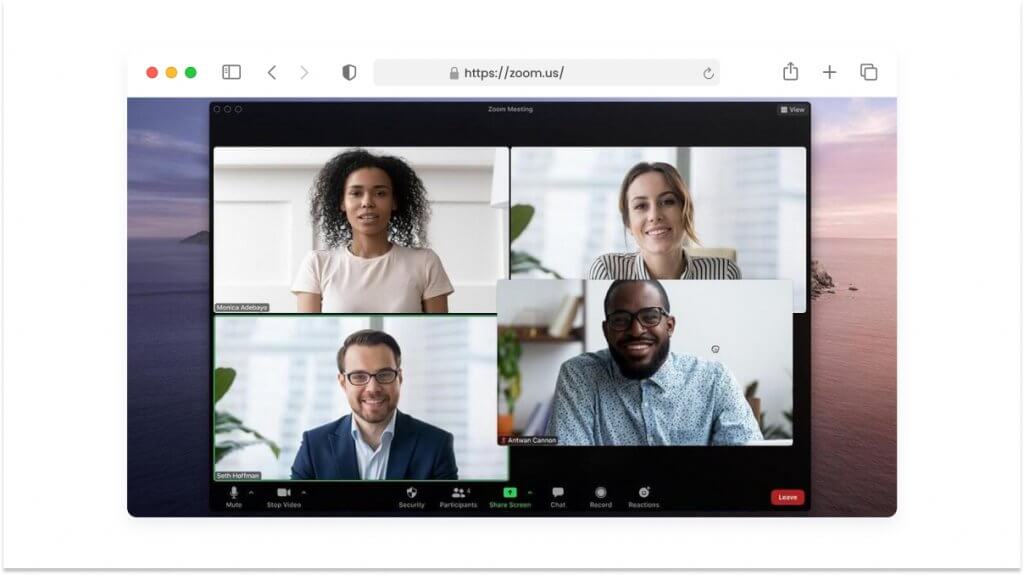
Zoom offers several different products for video webinars, meetings, phone systems, events, chat, and more. Zoom Meetings can host up to 1,000 participants with audience chats, and Zoom’s webinar platform can broadcast to 50,000 attendees. Virtual conference hosts can stream HD video, cancel background noise, and add virtual backgrounds with Zoom’s software.
Zoom’s key features include the capability to create their own post-conference landing page and set up reminder emails. To encourage audience participation, Zoom also offers Q&A sessions and attendee networking via breakout rooms.
Zoom’s Webinars starts at $690 per year (up to 500 attendees) and Zoom Webinar is priced at $890 per year (up to 500 attendees). At higher price points, the virtual event platform can serve over 10,000 live attendees.
6. Cisco Webex (Capterra Average Rating: 4.6 stars out of 5)
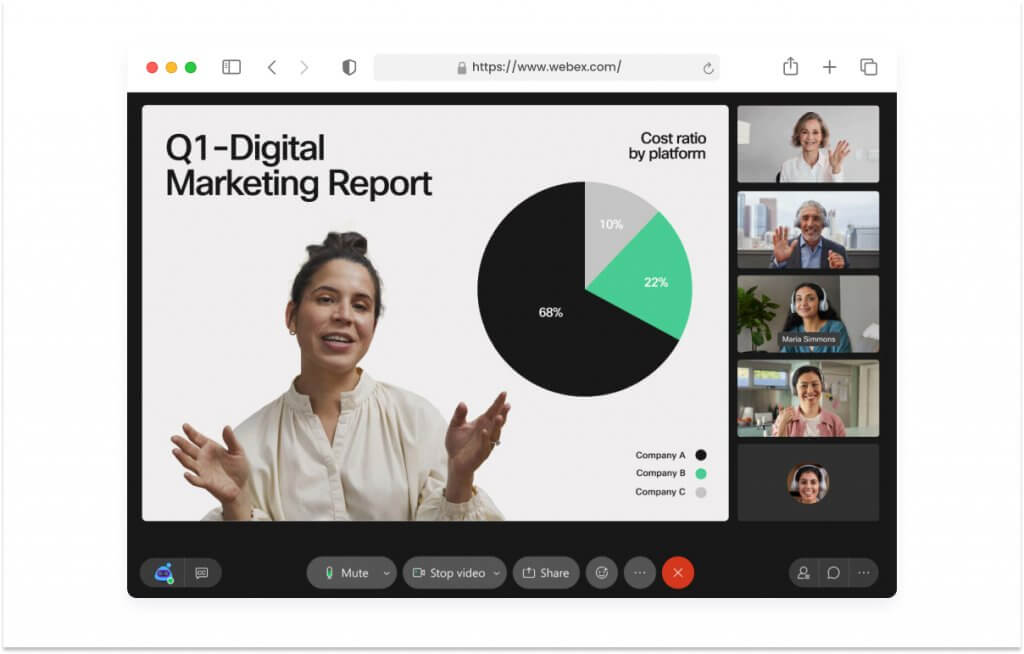
Cisco Webex is a virtual event platform that supports up to 10,000 attendees. To keep your attendees engaged, the platform offers breakout rooms (i.e. a virtual networking lounge), polls, chats, and Q&As.
The platform’s webinars come with post-event reporting, moderator controls, custom presentation options, and personalized registration pages. Cisco Webex offers several different pricing plans depending on each organizer’s needs.
The free basic plan is limited to 50-minute meetings and 100 attendees. The Business plan is $25 per month with support for 200 attendees. The enterprise plan provides support for up to 1000 attendees (contact sales for pricing).
7. Airmeet (Capterra Average Rating: 4.5 stars out of 5)
Airmeet is a platform that lets organizers host up to 100,000 participants for a hybrid or physical event. Organizers can connect attendees through mobile devices, live stream events on Facebook and YouTube, and use integrations to exchange event data.
With this hosting platform, organizers can add real-time polling, collect event insights, sell tickets with different tiers, and easily register attendees with registration forms.
The virtual event software has several plans, including social webinars and events. Both plans include interactive features such as the ability to gather audience questions.
Its plans include Social Webinars for results-driven webinars and Events for large-scale conferences. AirMeet has three plans: free, standard and pro. The free plan is limited to 100 attendees per event, while the standard plan (starts at $2400 per year) supports more users. To access all of the platform’s robust features (e.g. virtual booths, email marketing support, and networking features), see the pro plan which starts at $7500 per year.
8. GoToWebinar (Capterra Average Rating: 4.5 stars out of 5)
GoToWebinar is another virtual events platform that checks all the boxes of a top virtual events software. The video conferencing platform comes with powerful integrations, helpful analytics, engagement features, and flexible webinar modes. GoToWebinar comes with advanced security features and can quickly process credit card payments through Stripe.

GoToWebinar’s Webcast solution can host 3,000 to 100,000 attendees and its webinars can be pre-recorded which makes it a great pick for virtual community events. Content can be delivered through pre-recorded webinars, webcasting, and interactive live recording.
The platform has four plans: lite, standard, pro and enterprise. The lite plan starts at $49 per organizer per month and includes support for up to 250 participants. GoToWebinars also offers automated emails in each plan to support your email marketing campaigns
Its four pricing plans categorized by number of participants range from $49 per organizer per month to $399 per organizer per month.
9. Eventzilla (Capterra Average Rating: 4.4 stars out of 5)
Eventzilla is an all-in-one virtual conference software that also offers event registration for hybrid, virtual, and in-person events.
Event organizers can use this platform to build event agendas, run marketing campaigns, create mobile-friendly pages, and manage multiple events simultaneously.
Users can try Eventzilla for free. The Basic plan starts at $1.50 per event attendee up to a maximum of 100 attendees. For additional users, see the company’s higher-tier plans.
10. ClickMeeting (Capterra Average Rating: 4.2 stars out of 5)
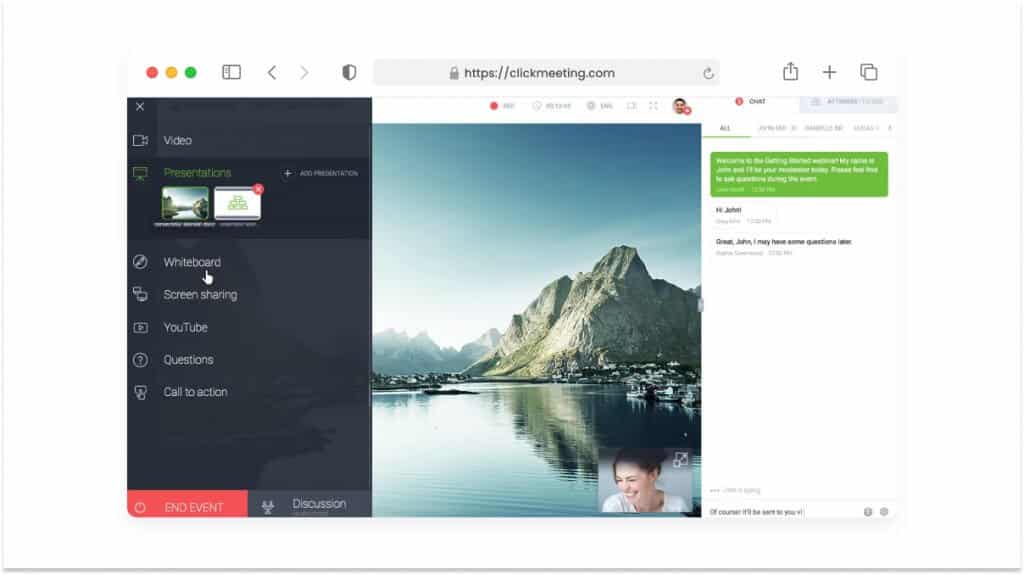
ClickMeeting is a virtual conference platform for hosting product demos, online business meetings, online training courses, and huge online events. Its huge virtual events product lets users host up to 10,000 attendees. Users can stream events live on YouTube or Facebook and add call-to-action buttons to generate conversions. The ability to connect to a wider audience on social media platforms when video streaming makes ClickMeeting appealing.
Some of ClickMeeting’s powerful features include paid webinars, live webinars, on-demand webinars, screen sharing, and webinar recording (i.e., support for event recording). The product comes with a 30-day free trial and three paid subscription plans.
ClickMeeting if one of the most affordable virtual conference platforms, with plans starting at $25 per month and pricing changing based on the number of attendees, integrations and other features.
How to Choose the Right Virtual Conference Platform
Assess Your Needs
Begin by identifying the specific needs of your event. Consider factors like the expected number of attendees, the type of interactions you want to facilitate (e.g., breakout rooms, Q&A sessions, networking features), and the level of technical support required. Understanding your goals will help you prioritize which features are essential for your virtual meeting platform.
Compare Features and Pricing
Once you have a clear understanding of your needs, compare the features and pricing of different platforms. Look for tools that offer the functionalities you need, such as live streaming, real-time chat, and analytics. Ensure the pricing aligns with your budget, and consider whether the platform offers scalable options to accommodate future growth.
Read User Reviews
User reviews can provide valuable insights into the reliability and user-friendliness of a platform. Look for reviews on trusted sites like Capterra and G2, paying attention to both positive and negative feedback. Reviews can reveal common issues and highlight features that users find particularly beneficial, helping you make an informed decision.
Conclusion
Whether you’re hosting a webinar, conference, or virtual training, consider using one of the top virtual conference platforms mentioned. One of the reasons that Grip is a fantastic option is because it integrates Arena Live Chat in its live event platform. To find out which product is best for you, sign up for a free trial and take each Arena product for a test drive yourself.
A common theme among many of these tools is the importance of attendee engagement. With software tools provided by Arena, you can enhance user engagement, collect customer data, and build relationships with your audience during video conferences.
To select a virtual event platform for your online conferences and virtual meetings, use this guide fully updated in 2022. While our focus is on larger virtual meetings, these platforms can often be used to run a smaller online meetings as well.
This guide reveals the top 10 virtual conference platforms, including features and pricing information for each so you can make a good decision as the event organizer.
Best Virtual Conference Platforms
Our rankings are informed by the Capterra average star rating provided to each platform as of August 2022. These rankings change over time as more users review the app.
1. Grip (Capterra Average Rating: 5 stars out of 5)

Grip offers virtual conference software suitable for virtual and hybrid event experiences. As the event host, you can stream your online experience to other major streaming solutions like Zoom, YouTube, and Twitch. The software enhances networking, a key part of the attendee experience, through its AI-powered event matchmaking tool. Organizers can add a live stream to Grip’s main stage, and it automatically shows content on the users’ feeds.
The platform’s Event Matchmaking tool creates a networking experience through speed networking, roundtables, instant video calls, multi-person meetings, and hosted buyer meetings. This matchmaking capability makes this platform stand out compared to other virtual meeting platforms.
In addition to major streaming solutions, Grip also integrates with Arena to enhance audience engagement. Arena Live Chat is a live chat tool that improves engagement through instant messaging, Q&As, polls, surveys, group chat, and more.
Arena Live Blog is another effective tool for digital agencies and companies looking to share quick updates as their conference unfolds. To capitalize on data collected from customers, companies also use Arena Personas plugged to their Customer Data Platform (CDP) to build customer profiles and better understand their preferences and interests.
2. Demio (Capterra Average Rating: 4.7 stars out of 5)

Demio is one of our top virtual conference platforms because of its simple event registration capabilities, engagement benefits, and analytics tools.
Demio offers real-time HD streaming, simulated events, and pre-recorded presentations. Organizers can add their own logo and branding, and attendees can join virtual conferences with just one click.
Notable, the Demio platform integrates with over 50 third-party software apps like HubSpot, Drip, ConvertKit, and MailChimp. Organizers can view attendees, collect contact details, manage their registration, and export contacts to a CSV file.
Demio offers a 14-day free trial, so you can evaluate if it is right for your needs. The company offers three paid plans: Starter ($34 per month with 50 attendees), growth ($69 per month with 150 attendees), and premium (request quote for pricing and support for more than 500 attendees).
3. Livestorm (Capterra Average Rating: 4.7 stars out of 5)

Livestorm is a browser-based platform that offers powerful live streaming features. Events can be hosted on desktop and mobile devices. The webinar software can be used for pre-recorded online events, live events, or on-demand events.
Organizers can track engagement, answer questions, add polls, chat with attendees, send emails, and use these insights to improve the experience for attendees.
Companies can promote their events through branded registration pages, built-in social sharing, company pages, automated emails, and more. Livestorm has solid features to enable an engaging interactive experience like Q&As for event guests, call-to-actions, live answer notifications, live attendees lists, and screen sharing.
Like several of the other video conferencing tools profiled here, Livestorm offers several plans. To take the platform for a test drive and see how it performs with interactive webinars, try the free plan which has a maximum event duration of 20 minutes. To accommodate more event participants, top-tier support, and other features, sign up for the Pro, Business, or Enterprise plan.
4. Communique Conferencing (Capterra Average Rating: 4.7 stars out of 5)

Communique Conferencing has effective solutions for audio conferencing, web conferencing, and virtual events. Its webcasting software lets organizers broadcast video and audio to over 30,000 attendees. This large virtual venue capacity means the platform pairs well with even the largest events.
Its virtual conferencing platform creates an online environment that includes features for networking, keynote presentations, booths, exhibit halls, and conferences. It also has a custom solution for hosting virtual career fairs and hybrid events. To find out more about the platform’s pricing, contact the company.
5. Zoom (Capterra Average Rating: 4.6 stars out of 5)

Zoom offers several different products for video webinars, meetings, phone systems, events, chat, and more. Zoom Meetings can host up to 1,000 participants with audience chats, and Zoom’s webinar platform can broadcast to 50,000 attendees. Virtual conference hosts can stream HD video, cancel background noise, and add virtual backgrounds with Zoom’s software.
Zoom’s key features include the capability to create their own post-conference landing page and set up reminder emails. To encourage audience participation, Zoom also offers Q&A sessions and attendee networking via breakout rooms.
Zoom’s Webinars starts at $690 per year (up to 500 attendees) and Zoom Webinar is priced at $890 per year (up to 500 attendees). At higher price points, the virtual event platform can serve over 10,000 live attendees.
6. Cisco Webex (Capterra Average Rating: 4.6 stars out of 5)

Cisco Webex is a virtual event platform that supports up to 10,000 attendees. To keep your attendees engaged, the platform offers breakout rooms (i.e. a virtual networking lounge), polls, chats, and Q&As.
The platform’s webinars come with post-event reporting, moderator controls, custom presentation options, and personalized registration pages. Cisco Webex offers several different pricing plans depending on each organizer’s needs.
The free basic plan is limited to 50-minute meetings and 100 attendees. The Business plan is $25 per month with support for 200 attendees. The enterprise plan provides support for up to 1000 attendees (contact sales for pricing).
7. Airmeet (Capterra Average Rating: 4.5 stars out of 5)
Airmeet is a platform that lets organizers host up to 100,000 participants for a hybrid or physical event. Organizers can connect attendees through mobile devices, live stream events on Facebook and YouTube, and use integrations to exchange event data.
With this hosting platform, organizers can add real-time polling, collect event insights, sell tickets with different tiers, and easily register attendees with registration forms.
The virtual meeting software platform has several plans, including social webinars and events. Both plans include interactive features such as the ability to gather audience questions.
Its plans include Social Webinars for results-driven webinars and Events for large-scale conferences. AirMeet has three plans: free, standard and pro. The free plan is limited to 100 attendees per event, while the standard plan (starts at $2400 per ear) supports more users. To access all of the platform’s robust features (e.g. virtual booths, email marketing support, and networking features), see the pro plan which starts at $7500 per year.
8. GoToWebinar (Capterra Average Rating: 4.5 stars out of 5)
GoToWebinar is another virtual events platform that checks all the boxes of a top virtual events software. The video conferencing platform comes with powerful integrations, helpful analytics, engagement features, and flexible webinar modes. GoToWebinar comes with advanced security features and can quickly process credit card payments through Stripe.

GoToWebinar’s Webcast solution can host 3,000 to 100,000 attendees and its webinars can be pre-recorded which makes it a great pick for digital events. Content can be delivered through pre-recorded webinars, webcasting, and interactive live recording.
The platform has four plans: lite, standard, pro and enterprise. The lite plan starts at $49 per organizer per month and includes support for up to 250 participants. GoToWebinars also offers automated emails in each plan to support your email marketing campaigns
Its four pricing plans categorized by number of participants range from $49 per organizer per month to $399 per organizer per month.
9. Eventzilla (Capterra Average Rating: 4.4 stars out of 5)
Eventzilla is an all-in-one virtual conference software that also offers event registration for hybrid, virtual, and in-person events.
Event organizers can use this platform to build event agendas, run marketing campaigns, create mobile-friendly pages, and manage multiple events simultaneously.
Users can try Eventzilla for free. The Basic plan starts at $1.50 per event attendee up to a maximum of 100 attendees. For additional users, see the company’s higher-tier plans.
10. ClickMeeting (Capterra Average Rating: 4.2 stars out of 5)

ClickMeeting is a virtual conference platform for hosting product demos, online business meetings, online training courses, and huge online events. Its huge virtual events product lets users host up to 10,000 attendees. Users can stream events live on YouTube or Facebook and add call-to-action buttons to generate conversions. The ability to connect to a wider audience on social media platforms when video streaming makes ClickMeeting appealing.
Some of ClickMeeting’s powerful features include paid webinars, live webinars, on-demand webinars, screen sharing, and webinar recording (i.e., support for event recording). The product comes with a 30-day free trial and three paid subscription plans.
ClickMeeting plans start at $25 per month and pricing changes based on the number of attendees, integrations and other features.
Conclusion
Whether you’re hosting a webinar, conference, or virtual training, consider using one of the top virtual conference platforms mentioned. One of the reasons that Grip is a fantastic option is because it integrates Arena Live Chat in its live event platform. To find out which product is best for you, sign up for a free trial and take each Arena product for a test drive yourself.
A common theme among many of these tools is the importance of attendee engagement. With software tools provided by Arena, you can enhance user engagement, collect customer data, and build relationships with your audience during video conferences.



